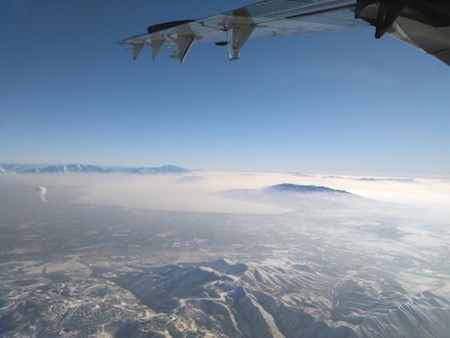UWFPS 2017

What: Utah Winter Fine Particulate Study (UWFPS)
When: 15 January - 14 February 2017
Where: Basins of northern Utah, including Salt Lake, Utah and Cache Valleys, and Great Salt Lake
How: NOAA Twin Otter aircraft and multiple ground sites throughout the region
Who: The aircraft project includes investigators from the NOAA ESRL Chemical Sciences Division and CIRES, the Utah Division of Air Quality (UDAQ), the University of Utah, the University of Toronto, the University of Washington, and the U.S. Department of Agriculture (USDA). Ground based investigators come from multiple institutions with support from UDAQ and EPA.
The urban air basins along Utah's Wasatch Mountains, a region with 2.4 million residents, experience some of the most severe particulate matter (PM) air pollution in the Nation. Particulate matter concentrations smaller than 2.5 microns (PM2.5) in Salt Lake City exceed the National Ambient Air Quality Standard (NAAQS, 35 µg m–3, 24 hours) on average 18 days out of the year. The majority of exceedance days occur in December, January and early February during a period when winter meteorology leads to strong, multi-day inversions known as persistent cold air pools. The Utah Division of Air Quality is currently developing a State Implementation Plan to address the NAAQS PM2.5 exceedances in this region.

The chemical composition of PM2.5 in northern Utah, and the mechanisms by which it forms, have received less attention than in other regions of the Nation despite the severity of the problem in Utah. The principal component of regional PM is ammonium nitrate, a secondary species that is responsible for up to 70% of PM mass during inversion periods and 40% outside of inversions. Residential wood combustion is thought to be an important source of organic aerosol during wintertime in western mountain basins, but its role in PM exceedances in Utah is not well quantified.
Chemical transformations responsible for formation of secondary aerosol such as ammonium nitrate likely take place within the cold pool inversion but at altitudes above surface level, making them difficult to characterize with ground based measurements alone. Twin otter flights with a chemically detailed payload are well suited to characterize the emissions, chemistry, transport patterns and spatial pollutant distributions associated with PM2.5 exceedances in the region.